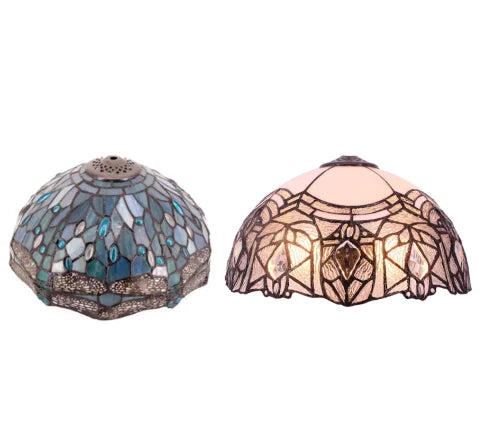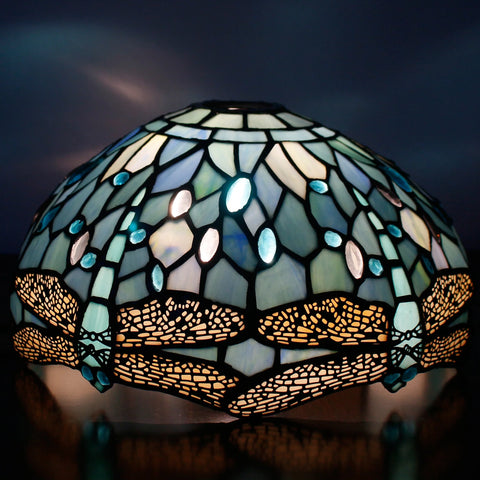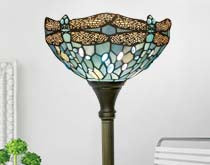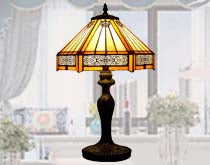How can I tell if a Tiffany style lamp is plastic or glass?
Tiffany style lamps are loved by many for their unique designs and colors. However, in the market, some manufacturers use plastic instead of glass to make these lamps in order to reduce cost.
So, how to differentiate between the two? In this article, we will explore the main characteristics of glass and plastic to help you identify the material of Tiffany lamps more accurately.

What is a Tiffany Lamp?
A Tiffany lamp is an iconic lighting fixture distinguished by its ornate design and vibrant stained glass shades. Originating in the late 19th century, these lamps, designed by Louis Comfort Tiffany, feature intricate patterns and colorful Glass crafted with meticulous precision.
Renowned for their elegance and craftsmanship, Tiffany lamps often boast elaborate bases and lampshades assembled from meticulously cut, shaped, and soldered stained glass pieces. These lamps continue to captivate with their timeless beauty and serve as artistic statements in interior decor, showcasing a blend of artistry, innovation, and enduring charm.
Glass Types in Tiffany Lamps
Tiffany lamps boast intricate designs owing to the unique glass types employed. The Glass used in these iconic lamps is specifically formulated and crafted for its purpose. Tiffany glass, characterized by its colorful quality, offers a captivating spectrum of colors and textures. Crafted with meticulous attention to detail, it undergoes processes like hand-cutting, shaping, and assembly, resulting in exquisite lampshades that radiate warmth and charm.
What distinguishes Tiffany glass is its ability to create depth and shimmer through its opalescent nature, adding an enchanting allure to these timeless pieces. This specialized glass enhances the intricate patterns and designs, lending each lamp its distinctive beauty and making Tiffany lamps prized pieces for collectors and enthusiasts alike.
Distinguishing Tiffany Glass vs. Stained Glass
Distinguishing between Tiffany glass and traditional stained Glass involves understanding their unique characteristics. Tiffany glass, a subset of stained Glass, stands out due to its specific composition and craftsmanship techniques.
Tiffany glass exhibits opalescent qualities, often incorporating various colors and textures within a single piece. This Glass undergoes a meticulous process, including blending metallic oxides to create vibrant hues and employing techniques like copper foil or Lead came to join the glass pieces.
Conversely, traditional stained Glass comprises colored glass pieces joined using Lead, showcasing different shades and textures but typically lacking the colorful quality of Tiffany glass. Stained Glass commonly relies on painted or stained surfaces to achieve color variations.
The key difference lies in the depth and luminosity created by the colorful quality of Tiffany's glass, giving it a distinct shimmering effect compared to the more flat and painted appearance of traditional stained Glass. Understanding these nuances aids in identifying and appreciating the unique beauty of Tiffany glass in comparison to traditional stained glass techniques.

How To Identify Glass or Plastic in Tiffany Lamps
Marveling at the allure of a Tiffany-style lamp often sparks the query: Is the exquisite lampshade meticulously crafted from glass or plastic? Knowing how to distinguish between these materials can elevate your appreciation for these stunning pieces. With a few simple techniques, you can unravel this mystery. Let's explore step-by-step methods to identify whether the lampshade of a Tiffany-style fixture is made of Glass or plastic.
Characteristics of Glass
- Weight: glass is denser, so it is usually much heavier than plastic. When you pick up a Tiffany lamp, if it feels relatively heavy, it is most likely made of glass.
- Temperature: Glass conducts heat less well, so it usually feels colder than plastic. You can gently touch the surface of the fixture with your finger and if it feels cool, then it is probably glass.
- Texture: Glass has a smooth and delicate surface, giving it a clear and transparent look.
- Reflectivity: Glass is highly reflective, reflecting light better and making it brighter.
- Cleaning and Maintenance: The surface of glass is not easily scratched and is relatively easy to clean. Moreover, most cleaners will not damage the glass.
Characteristics of Plastic
- Weight: Plastic is less dense, so it is lighter than glass. This makes plastic products easier to carry and install.
- Temperature: Plastic conducts heat better than glass, so it is usually warmer to the touch than glass.
- Texture: Plastic may have a slightly rougher surface, especially in lower quality plastics, and may not be as clear as glass.
- Reflectivity: Plastics are less reflective and may not be as bright as glass.
- Cleaning and Maintenance: Some plastics are easily scratched and may be damaged by certain cleaning agents. Therefore, special care needs to be taken when cleaning plastics.
Identification Methods
1. Touch feeling
Glass: Since glass has poor thermal conductivity, when you touch it, it usually feels colder than its surroundings. This cold sensation is especially noticeable in warm weather or indoor environments.
Plastic: In contrast, plastic has better thermal conductivity, so it will feel relatively warm to the touch, especially at room temperature.
2. Tapping sound
Glass: Uncut glass makes a crisp tinkling sound when gently tapped. However, for Tiffany lamps, since they are made of multiple pieces of glass welded together, they will make a duller thump when tapped, which may mislead people into thinking that they are made of plastic.
Plastic: Plastic, when struck, usually has a duller sound and lacks the crispness of glass.
3. Observing the seams
Glass: A real Tiffany glass fixture is made up of multiple pieces of glass, and these pieces will have lead seams between them to hold them in place. These seams are solid and you can feel them.
Plastic: Plastic may mimic the effect of glass seams, but these seams are usually just surface textures and you can't really feel them.
4. Use of light
Glass: When light passes through glass, the glass diffuses the light evenly, making the light softer and the color and texture of the glass more vivid.
Plastic: Plastic reflects and transmits light differently than glass. Light may not be scattered as evenly as glass, and the color of plastic may appear duller.
5. Weight comparison
Glass is heavier than plastic. Carefully lift the lamp or lampshade and gauge its weight. If it feels relatively lightweight, it's more likely made of plastic.
6. Rubbing alcohol test
Apply a small amount of rubbing alcohol to an inconspicuous area on the lampshade using a cotton swab. If the surface is plastic, the swab may pick up some color residue. Glass won't show any such residue.
7. Consultation or documentation
Ensure to inspect any documents or specifications provided by the manufacturer or seller. Newer Tiffany-style lamps may specify whether they use glass or plastic components. If in doubt, consult experts or reach out to the manufacturer for clarification.
Real Tiffany lamp Vs Imitation Tiffany
Real Tiffany lamps are made from high-quality glass, each piece is carefully selected and cut, then joined together by lead-soldered seams. This process ensures that each lamp is a unique work of art. When you strike it, you will hear a more thumping sound than the clinking of a single piece of glass due to the lead seams between the pieces.
Imitations may use lower-quality materials such as plastic or thinner glass. These fixtures may be machine-made and lack the detail and uniqueness of real Tiffany fixtures. When you tap on an imitation, it may not make the characteristic sound of a real Tiffany fixture.
You can check out how to recognize real stained glass lamps here.

Do Tiffany Lamps Contain Lead?
Tiffany lamps, admired for their beauty, often historically contained Lead. The Lead was primarily used in the soldering process to join the intricate pieces of stained Glass. This technique provided stability and strength to the lampshade. However, due to health concerns associated with lead exposure, modern manufacturers have made adjustments.
Contemporary versions of Tiffany-style lamps strive to meet safety standards by using lead-free solder. These updated designs aim to eliminate potential health risks while maintaining the aesthetic allure of the lamps. Suppose you need clarification on whether a Tiffany lamp contains Lead. In that case, it's advisable to check the product specifications or consult the manufacturer or seller for detailed information.
Being aware of the presence of Lead or opting for certified lead-free options ensures not just the lamp's beauty but also the safety of your living space. Always prioritize safety measures, especially when dealing with antique or older Tiffany lamps that might still contain lead-based solder.
Remember, when in doubt, consulting with an expert or the lamp's manufacturer can provide invaluable insights into its composition.
Related reading: What styles will Tiffany lamps match in 2022?
Conclusion
You can take the Tiffany style lamp in your hands and test it by following the above method. Although Tiffany style lamps are not as good as authentic Tiffany lamps, they exist to fulfill the needs of users who want to appreciate Tiffany style lamps at an acceptable price. This post is not to tell you that plastic glass Tiffany style lamps are bad, but rather for you to learn the difference and buy the Tiffany style lamp you expect to appreciate its beauty and charm. If you want to buy a quality Tiffany style lamp, werfactory factory will satisfy you. View: Werfactory tiffany lamps.



























